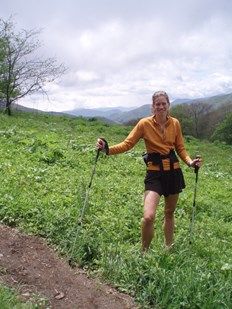
“I couldn’t go back to the trail without my stick! The constant ups and downs with 30 pounds on my back were very hard on my knees, and without a stick they would be unbearable. My hiking stick had become an extension of my hand — I was lost without it.”
That’s 33-year-old Jennifer Pharr Davis of Asheville, who has hiked more than 13,000 miles on six continents, including a 2011 thru-hike of the Appalachian Trail that set the record for hiking the 2,175-mile trail faster than anyone at that point: 46 days, 11 hours, and 20 minutes (that’s about 47 miles a day).
Her painful discovery, recounted in her book, “Becoming Odyssa: Epic Adventures on the Appalachian Trail” (about her first AT thru-hike) came as she discovered that the truck she’d hitched into town on had departed with her beloved hiking stick — her crutch, to a degree — on board.
We came across the passage as Jennifer Pharr Davis prepares to hike the Mountains-to-Sea Trail in celebration of the 1,175-mile statewide trail’s 40th anniversary. We share the anecdote in our ongoing effort to get more of you to embrace trekking poles.
Why use trekking poles? We’ll defer to an expert, Dr. Edward R. Laskowski with the Mayo Clinic.
“Walking poles work your arms, shoulders, chest and upper back muscles through a functional range of motion as you walk — which can help you turn your daily walk into a full-body workout,” according to Dr. Laskowski. “The arm movement associated with walking poles adds intensity to your aerobic workout, which helps you burn more calories.”
Further, he adds:
- Walking poles improve balance and stability. This is especially helpful on the rocky, rooty trails of the Southeast, a region where stream crossings are common and balance and stability is especially critical.
- Walking poles help you maintain proper posture, especially in the upper back, and may help to strengthen upper back muscles.
- Walking poles take some of the load off your lower back, hips and knees, which may be helpful if you have arthritis or back problems.
Hiking poles aren’t expensive. You can spend around $20 on a pair just to see if you like them. Lighter poles that are easier to adjust to your height will run $70 and up.
For a reasonable price, trekking poles will make your hikes happier today and simply possible on down the line.
* * *
Poles apart?
Not sure how to tell trekking poles apart, to determine which ones may be right for you? Check out these recommendations from two of our favorite sources:
SectionHiker.com: Top 10 Backpacker Recommended Trekking Poles
Outdoor Gear Lab: The Best Trekking Poles
* * *
Jennifer Pharr Davis
Jennifer Pharr Davis, who lives in Asheville, will head out on the MST in mid-August, spending three months on the trail and making appearances along the way. Learn more about Jennifer’s hike as part of the Mountains-to-Sea Trail’s 40th anniversary celebration here.
And learn more about Jennifer in this profile we wrote for Great Outdoor Provision Co.